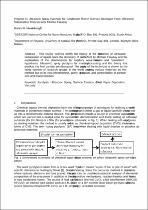 ResearchSpace
ResearchSpace
Progress in ultrasonic spray pyrolysis for condensed matter sciences developed from ultrasonic nebulization theories since Michael Faraday
JavaScript is disabled for your browser. Some features of this site may not work without it.
- ResearchSpace
- →
- Research Publications/Outputs
- →
- Journal Articles
- →
- View Item
| dc.contributor.author |
Mwakikunga, Bonex W

|
|
| dc.date.accessioned | 2014-09-22T13:45:29Z | |
| dc.date.available | 2014-09-22T13:45:29Z | |
| dc.date.issued | 2014 | |
| dc.identifier.citation | Mwakikunga, B.W. 2014. Progress in ultrasonic spray pyrolysis for condensed matter sciences developed from ultrasonic nebulization theories since Michael Faraday. Critical Reviews in Solid State and Materials Sciences, vol. 39(1), pp 46- 80 | en_US |
| dc.identifier.issn | 1040-8436 | |
| dc.identifier.uri | http://www.tandfonline.com/doi/pdf/10.1080/10408436.2012.687359 | |
| dc.identifier.uri | http://hdl.handle.net/10204/7684 | |
| dc.identifier.uri | https://doi.org/10.1080/10408436.2012.687359 | |
| dc.description | Copyright: 2014 Taylor & Francis. The definitive version is published in Critical Reviews in Solid State and Materials Sciences, vol. 39(1), pp 46- 80 | en_US |
| dc.description.abstract | This review outlines, in great detail, the history of the phenomenon of ultrasonic nebulization of liquids since the discovery of such an effect by Michael Faraday and the explanation of the phenomenon by capillary wave mechanism and “cavitation” hypothesis. Capillary waves described by the Kelvin equation are confirmed by Lang’s experiment and more theoretical models by Peskin & Raco and Jokanovic. Cavitation bubbles have been elaborated by the Rayleigh-Plesset equation as well as the correlation equations between predicted and experimentally measured droplet diameter. Correlation equations such as one by Rajan & Pandit and Avvaru et al. have been considered. Ultrasonic spray pyrolysis for materials processing and the theories that predict the final particle size distribution are introduced. The popularity of the technique is shown by the rising number of research groups in the world processing various materials by this method due to its cost-effectiveness, purity of its products, and controllability of particle size as well as final properties. | en_US |
| dc.language.iso | en | en_US |
| dc.publisher | Taylor & Francis | en_US |
| dc.relation.ispartofseries | Workflow;13367 | |
| dc.subject | Pyrolysis | en_US |
| dc.subject | Ultrasonic spray | en_US |
| dc.subject | Surface tension | en_US |
| dc.subject | Chemical vapor deposition | en_US |
| dc.subject | Viscosity | en_US |
| dc.title | Progress in ultrasonic spray pyrolysis for condensed matter sciences developed from ultrasonic nebulization theories since Michael Faraday | en_US |
| dc.type | Article | en_US |
| dc.identifier.apacitation | Mwakikunga, B. W. (2014). Progress in ultrasonic spray pyrolysis for condensed matter sciences developed from ultrasonic nebulization theories since Michael Faraday. http://hdl.handle.net/10204/7684 | en_ZA |
| dc.identifier.chicagocitation | Mwakikunga, Bonex W "Progress in ultrasonic spray pyrolysis for condensed matter sciences developed from ultrasonic nebulization theories since Michael Faraday." (2014) http://hdl.handle.net/10204/7684 | en_ZA |
| dc.identifier.vancouvercitation | Mwakikunga BW. Progress in ultrasonic spray pyrolysis for condensed matter sciences developed from ultrasonic nebulization theories since Michael Faraday. 2014; http://hdl.handle.net/10204/7684. | en_ZA |
| dc.identifier.ris | TY - Article AU - Mwakikunga, Bonex W AB - This review outlines, in great detail, the history of the phenomenon of ultrasonic nebulization of liquids since the discovery of such an effect by Michael Faraday and the explanation of the phenomenon by capillary wave mechanism and “cavitation” hypothesis. Capillary waves described by the Kelvin equation are confirmed by Lang’s experiment and more theoretical models by Peskin & Raco and Jokanovic. Cavitation bubbles have been elaborated by the Rayleigh-Plesset equation as well as the correlation equations between predicted and experimentally measured droplet diameter. Correlation equations such as one by Rajan & Pandit and Avvaru et al. have been considered. Ultrasonic spray pyrolysis for materials processing and the theories that predict the final particle size distribution are introduced. The popularity of the technique is shown by the rising number of research groups in the world processing various materials by this method due to its cost-effectiveness, purity of its products, and controllability of particle size as well as final properties. DA - 2014 DB - ResearchSpace DP - CSIR KW - Pyrolysis KW - Ultrasonic spray KW - Surface tension KW - Chemical vapor deposition KW - Viscosity LK - https://researchspace.csir.co.za PY - 2014 SM - 1040-8436 T1 - Progress in ultrasonic spray pyrolysis for condensed matter sciences developed from ultrasonic nebulization theories since Michael Faraday TI - Progress in ultrasonic spray pyrolysis for condensed matter sciences developed from ultrasonic nebulization theories since Michael Faraday UR - http://hdl.handle.net/10204/7684 ER - | en_ZA |





